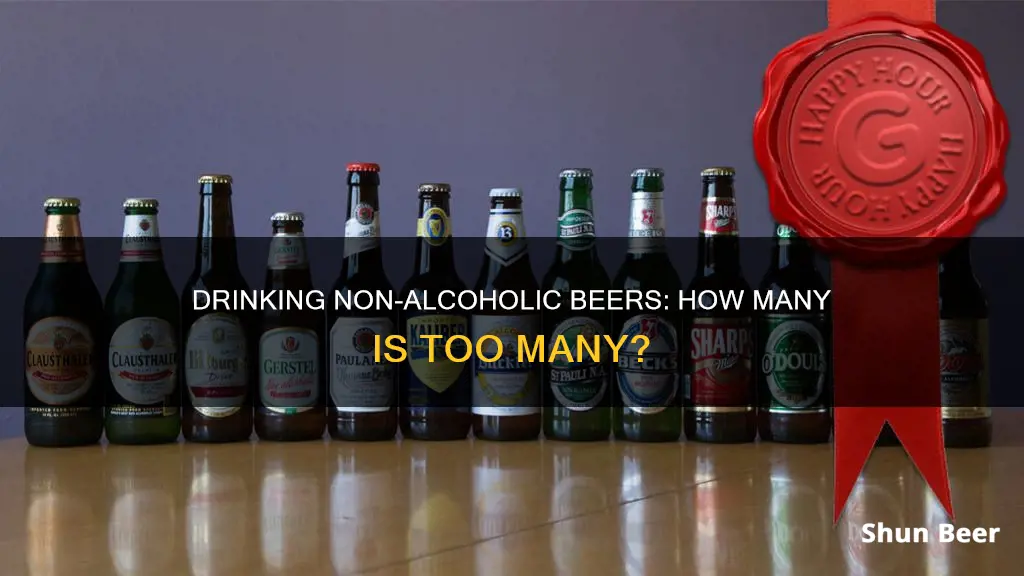
Non-alcoholic beer has become increasingly popular in recent years, with the global market valued at $18 billion in 2020 and expected to reach $25 billion by 2024. But how many non-alcoholic beers can you drink?
Non-alcoholic beer typically contains up to 0.5% alcohol by volume (ABV). While it is almost impossible for an adult to get drunk from drinking non-alcoholic beer, it is important to note that it is not completely alcohol-free. The amount of alcohol in non-alcoholic beer is similar to that found in ripe bananas, bread, and some yogurts or juices.
According to research, it would take approximately 40 cans of non-alcoholic beer to consume the amount of alcohol typically needed to feel drunk. This is because the body processes the alcohol in non-alcoholic beer almost as quickly as it is consumed.
What You'll Learn

Non-alcoholic beers are almost impossible to get drunk on
Non-alcoholic beers are labelled as such when they contain 0.5% alcohol by volume (ABV) or less. Beers with an ABV of 0.05% to 0.5% must be labelled as "dealcoholised" in the UK, but drinks with an ABV of up to 0.5% don't require retailers to have a licence to sell them, and their producers don't pay alcohol duty.
Most people start to feel the minor effects of alcohol, such as feeling relaxed and a minor impairment of reasoning and memory, when their blood alcohol content (BAC) reaches 0.04%. However, it's almost impossible for your BAC to reach this level when drinking low-ABV beer.
A 2012 study by German scientists found that 67 people who drank 1.5 litres (about 2.6 pints) of 0.4% ABV beer in an hour had a maximum BAC of 0.0056%. This is:
- 14 times lower than the drink-driving limit of 0.08% in England
- 9 times lower than the drink-driving limit of 0.05% in Scotland
- 7 times lower than the level (0.04%) that most people start to feel the effects of alcohol
The main reason why your BAC can't increase to a level that makes you feel drunk when drinking low-ABV beer is that your body processes the alcohol almost as quickly as you drink it. For example, a pint of 0.5% beer contains about 0.28 units or 2.2g of alcohol, which the average person's body will process in around 16 minutes.
Therefore, even if you drink several pints of 0.5% beer in quick succession, your body will process the alcohol before you can start to feel drunk.
Jason Kelce's Beer Choice: What Was He Drinking?
You may want to see also

They are designed to match the taste, look and feel of standard beers
The main difference between alcoholic, low-alcohol, and alcohol-free beers is the amount of alcohol they contain. Alcohol-free and low-alcohol beers are designed to match the taste, look, and feel of standard beers.
Alcohol-free beers typically contain 0.05% alcohol by volume (ABV) or less, although they can contain up to 0.5% ABV and still be labelled as alcohol-free. A half-litre can (500ml) of a 0.5% ABV beer contains 0.25 units of alcohol (a quarter of a unit of alcohol).
Low-alcohol beers contain 1.2% ABV or less. A half-litre can of 1.2% ABV beer has 0.6 units of alcohol (6 ml of pure alcohol).
The average strength of conventional beers is 4.4% ABV. A half-litre can of 4.4% ABV beer contains 2.2 units of alcohol (22 ml of pure alcohol).
Recent advances in production technology mean that alcohol-free and low-alcohol beers are now more likely to match the taste of conventional beers. For example, the Heineken 0.0 non-alcoholic lager has been described as a "good match" for the original Heineken lager, with its characteristic "fruity notes and soft maltiness".
Alcohol-free and low-alcohol beers are made using the same ingredients as standard beers: water, malt, hops, and yeast. The alcohol content can be controlled or reduced in several ways:
- The brewing process is controlled using special non-fermenting ingredients to stop the amount of alcohol in the beer from exceeding 0.5% ABV (or 1.2% for 'low alcohol' beers).
- Alcohol is removed by heating the drink until the alcohol evaporates or by using a process called reverse osmosis, which passes the beer through a fine mesh to remove the alcohol while leaving the other flavoured parts behind.
- The beer is blended with something non-alcoholic, such as lemon or other flavoured soda to create a radler or shandy.
Sales of alcohol-free beer in the UK have more than tripled in the last five years, and consumers have reported that the taste has improved.
Drinking Beer on Thai Beaches: What's Allowed?
You may want to see also

They can help you cut your alcohol intake
Non-alcoholic beers are a great way to cut down on your alcohol consumption. They are designed to match the taste, look, and feel of standard beers, so you don't have to compromise on flavour. In recent years, advances in production technology have made it easier to find a non-alcoholic beer that suits your palate.
Non-alcoholic beers typically contain 0.05% alcohol by volume (ABV) or less. Beers with an ABV of 0.05% to 0.5% must be labelled as "dealcoholised" in the UK, while those with less than 0.05% ABV can be labelled as "alcohol-free" or "non-alcoholic". It's worth noting that beers labelled as "alcohol-free" may still contain trace amounts of alcohol, so they are not suitable for those who need or want to avoid alcohol completely.
Swapping a standard beer for a non-alcoholic one can help reduce your overall alcohol intake. For example, a half-litre can of a 4.4% ABV beer contains 2.2 units of alcohol, while a non-alcoholic beer with 0.5% ABV contains only 0.25 units. This means that by making the switch, you can still enjoy the taste of beer while sticking to low-risk drinking guidelines.
Non-alcoholic beers are generally healthier than their alcoholic counterparts. Alcohol contains empty calories—about seven calories per gram—which provide no nutritional value. In contrast, non-alcoholic beers have fewer calories and are better for sleep, post-exercise recovery, and liver, heart, and mental health. Additionally, drinking alcohol can impair judgment and block satiety hormones, leading to overeating and increased appetite.
It is nearly impossible for an adult to get drunk from drinking non-alcoholic beer. Most people start to feel the effects of alcohol when their blood alcohol content (BAC) reaches 0.04%. However, since your body processes the low amounts of alcohol in non-alcoholic beer almost as quickly as you drink it, your BAC is unlikely to reach this level.
In a 2012 German study, participants drank 1.5 litres of non-alcoholic beer (0.4% ABV) in an hour, and the maximum BAC recorded was 0.0056%—significantly lower than the drunk driving limit in many countries.
Stale Beer: Is It Safe to Drink?
You may want to see also

They are not suitable for those dependent on alcohol or in recovery
It is important to understand that non-alcoholic beverages are not a safe alternative for individuals struggling with alcohol dependence or those in recovery from an alcohol use disorder. While non-alcoholic drinks contain little to no alcohol, they can still trigger cravings and impair judgment, leading to a potential relapse.
For individuals dependent on alcohol, even small amounts of alcohol can have detrimental effects. Non-alcoholic beers typically contain less than 0.5% alcohol by volume, which may seem insignificant but can still be harmful to those struggling with addiction. The small amount of alcohol present can act as a "reminder" of the substance, triggering intense cravings and increasing the risk of relapse. Additionally, for individuals in recovery, consuming non-alcoholic drinks can disrupt the progress made in rewiring the brain's reward pathways and establishing new, healthy habits.
The recovery process often involves abstaining from any substance that can alter one's mental state, including non-alcoholic drinks. This is because the brain is still healing and vulnerable to triggers and cravings. Relapse is a serious concern, and even one drink can set off a chain reaction, leading to a loss of control and a return to unhealthy drinking patterns. Maintaining complete abstinence is often the safest and most effective approach for those in recovery.
It is crucial for those dependent on alcohol or in recovery to seek alternative beverages and activities that do not involve alcohol. There are numerous non-alcoholic options available, such as sparkling waters, herbal teas, and mocktails, which can provide a satisfying and enjoyable experience without the risks associated with alcohol. Support groups, therapy, and other healthy coping mechanisms are also vital components of a sustainable recovery plan.
The bottom line is that non-alcoholic drinks are not a safe option for those with alcohol dependence or in recovery. While they may seem harmless, they can undermine the progress and stability of individuals working hard to overcome their addiction. It is essential to prioritize one's health and sobriety by avoiding these beverages and focusing on alternative, healthy options that support long-term recovery and a fulfilling life free from alcohol dependence.
Alcohol-Free Beer: Safe or Risky for Recovering Alcoholics?
You may want to see also

They are healthier than regular beers
Non-alcoholic beers are healthier than regular beers. Firstly, they are a great way to reduce alcohol intake, which is classified as a toxic and psychoactive substance by the World Health Organization (WHO). Alcohol contributes to 3 million deaths each year globally and is responsible for more than 5.1% of the global burden of disease.
Non-alcoholic beers are also better for your health because they have fewer calories. Alcohol contains 7 calories per gram, which is almost as many as pure fat. Therefore, non-alcoholic beers can be a helpful way to cut down on calories and maintain a healthy weight.
In addition, non-alcoholic beers can help improve alcohol-related sleep issues. A 2018 study published in the Journal of Medical Internet Research found that just two drinks per day for men and one drink per day for women (classified as moderate drinking) decreased sleep quality by 24%.
Non-alcoholic beers may also have a positive impact on your diet. Alcohol is believed to impact ghrelin production, a hormone that stimulates appetite and food intake. This may explain why drinking alcohol can give you late-night cravings.
Finally, non-alcoholic beers can be beneficial for those who are pregnant or have substance use disorders. However, it is important to note that non-alcoholic beers do contain trace amounts of alcohol, so they may not be suitable for everyone.
Beer and Kidney Stones: Post-Surgery Drinking Explored
You may want to see also
Frequently asked questions
It is not recommended to drink any alcohol and then drive, but if you are drinking non-alcoholic beers, you can legally drive in most parts of the UK if your blood alcohol concentration (BAC) is below 0.08%20 non-alcoholic beers to reach the same BAC as drinking one regular beer.
Most people start to feel the effects of alcohol when their BAC reaches 0.04%. It is almost impossible for your BAC to reach this level from drinking non-alcoholic beer, even if you drink several pints.
Non-alcoholic beers are not completely alcohol-free, but they do allow your body to process alcohol much quicker, so you can stay in control and hydrated even if you drink five or six pints.







